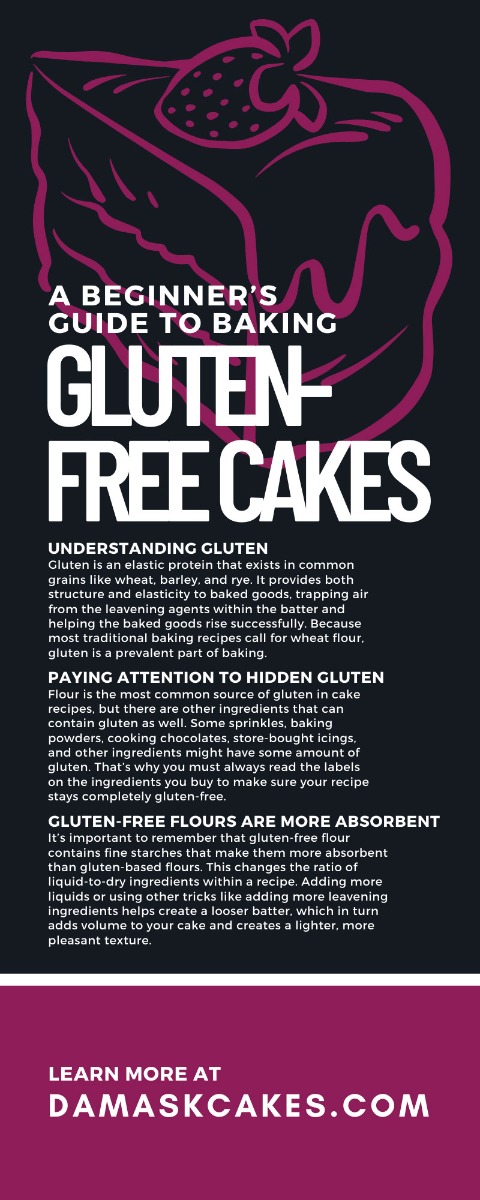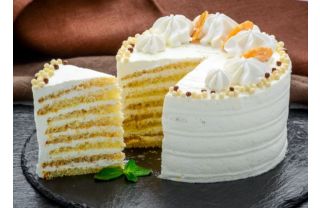Baking should be for everyone. With alternative ingredients gaining popularity and people sharing recipes across the world every day, it’s easier than ever to accommodate different food preferences and health needs—including gluten intolerance. Gluten plays a significant role in traditional baking, but with the right ingredients and knowledge, you can substitute different grains and flours to cut it out entirely. See how you can create gluten-free treats without sacrificing quality with this beginner’s guide to baking gluten-free cakes.
Understanding Gluten
Creating gluten-free baked goods is about more than simply removing any gluten-based ingredients and replacing them with gluten-free alternatives. You must also understand what gluten is and how it interacts with other parts of the recipe. This is what allows you to adjust ingredients and techniques to make your gluten-free alternative successful.
Gluten is an elastic protein that exists in common grains like wheat, barley, and rye. It provides both structure and elasticity to baked goods, trapping air from the leavening agents within the batter and helping the baked goods rise successfully. Because most traditional baking recipes call for wheat flour, gluten is a prevalent part of baking.
Understanding Gluten Substitutes
It’s important to note that gluten-based flours like all-purpose wheat flour have a unique composition. You can’t replace it with a single gluten-free grain, as this won’t provide the right mixture and it won’t react with other ingredients the same way that gluten-based flour does. The key is to use multiple gluten-free flours or binders to recreate the effects of traditional flour.
Alternatively, you can use a pre-mixed gluten-free flour combination. One example is the gluten-free flour in Damask Cake’s gluten-free baking kits, which uses a combination of rice flours, xanthan gum, starches, and other ingredients to create a successful batter.
Paying Attention to Hidden Gluten
Flour is the most common source of gluten in cake recipes, but there are other ingredients that can contain gluten as well. Some sprinkles, baking powders, cooking chocolates, store-bought icings, and other ingredients might have some amount of gluten. That’s why you must always read the labels on the ingredients you buy to make sure your recipe stays completely gluten-free. This is another great reason to choose a gluten-free cake kit. With completely gluten-free ingredients and step-by-step instructions, you can ensure your gluten-free baking is a tasty success.
Gluten-Free Flours Are More Absorbent
In addition to using the right ingredients, there are a few tips to round out this beginner’s guide to baking gluten-free cakes. First, it’s important to remember that gluten-free flour contains fine starches that make them more absorbent than gluten-based flours. This changes the ratio of liquid-to-dry ingredients within a recipe. Adding more liquids or using other tricks like adding more leavening ingredients helps create a looser batter, which in turn adds volume to your cake and creates a lighter, more pleasant texture.
You’re Allowed To Overmix Gluten-Free Batters
If you’ve spent a lot of time baking in the past, you’ve probably heard or read about the dangers of overmixing your batter. Overmixing makes gluten-based batters tough and hard to work with; however, this is purely because of gluten’s elasticity. Without gluten, there’s no danger of overmixing your ingredients. In fact, some gluten-free recipes call for longer mixing times to create a stronger structure and improve the rise of the batter.
You Must Let Your Batter Rest
Many people hesitate to try gluten-free baking recipes because they have a gritty texture. This is a common mistake, but it’s easy to fix. The problem stems from gluten-free grains being dryer and firmer. They also don’t mix as quickly as gluten-based batters. By letting the batter rest, you give the gluten-free flour more time to hydrate—this softens the grains and creates a smoother texture.
Half an hour of rest will usually do the trick. This step is particularly important in baked goods with a shorter baking time, but it’s a good idea any time you’re trying to work with overly dry or gritty baked goods.
Common Issues With Gluten-Free Cakes
No baker is perfect, especially if it’s your first time working with gluten-free ingredients. There are a few common issues that anyone can run into, so don’t worry. You can always take a step back, learn how to fix it, and try again. Here are some common problems to watch out for as you use gluten-free ingredients.
The Cake Won’t Rise
Getting your gluten-free cake to rise isn’t always as straightforward as it is with traditional ingredients. The problem is usually because the batter is too dense or the leavening agents—like baking soda, baking powder, or yeast—don’t combine with the other ingredients correctly.
Mixing your batter for a little longer helps beat more air into the batter, making it lighter and helping it rise. You might also want to adjust ingredients if you’re working from scratch or altering a traditional recipe. Gluten-free cakes often need a little more of the leavening agent, so try adding a little more—about a quarter of what the recipe calls for—to help it rise.
Adding an acid like apple cider vinegar or lemon juice can also help it rise. This will also create a more tender cake crumb, improving the overall taste and texture.
The Cake Is Too Dry
A dry, crumbly cake is messy and gritty. You can fix it by letting the batter rest to help soften the grains and avoid grittiness. You can also add an egg to the recipe to increase the moisture content. Other tips include using brown sugar instead of caster sugar or adding a touch of liquid sweetener—like honey or syrup—to the batter.
The Recipe Knows Best
Even if you’re an experienced baker, using gluten-free ingredients changes everything. Standard practices, ingredient ratios, visual baking cues—all of these are different when you’re working with gluten-free recipes. That’s why it’s important to work with a recipe you can trust. Following steps from the experts helps you navigate the unique properties of gluten-free ingredients. You’ll know how long to mix, what to expect for baking temperatures and times, and other specific practices that help you create a light, moist, and delicious gluten-free cake everyone can enjoy.
Master the art of gluten-free baking with cake kits from Damask Cakes. Browse our delectable range of recipes and find a new favorite today!







